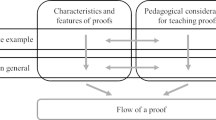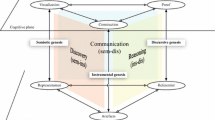Abstract
Through examples we explore the practice of mathematical pursuit, in particular on the notion of proof, in a cultural, socio-political and intellectual context. One objective of the discussion is to show how mathematics constitutes a part of human endeavour rather than standing on its own as a technical subject, as it is commonly taught in the classroom. As a “bonus”, we also look at the pedagogical aspect on ways to enhance understanding of specific topics in the classroom.


Similar content being viewed by others
Notes
Shi is a rather peculiar but extremely important social class throughout the whole cultural history of China. It is sometimes rendered in translation as ‘literati’, ‘scholar’, ‘scholar-official’, ‘intellectual’, but none of these terms individually can capture a holistic meaning of the word.
References
Alexander, A. R. (2002). Geometrical landscapes: the voyages of discovery and the transformation of mathematical practice. Stanford: Stanford University Press.
Antonini, S., & Mariotti, M. A. (2008). Indirect proof: what is specific of this mode of proving? (this issue of Zentralblatt für Didaktik der Mathematik).
Bacon, F. (1620/2000). The new organon. In L. Jardine, M. Silverthorne (Eds.). Cambridge: Cambridge University Press.
Calinger, R. (Ed.) (1982/1995). Classics of mathematics. Oak Park: Moore Publishers; reprinted, Englewood: Prentice Hall.
Chemla, K. (1996). Relations between procedure and demonstration. In H. N. Jahnke, et al. (Eds.), History of mathematics and education: ideas and experiences (pp. 69–112). Göttingen: Vandenhoeck & Ruprecht.
Chemla, K. (1997). What is at stake in mathematical proofs from third century China? Science in Context, 10(2), 227–251.
Davis, P. J. (2006). Mathematics and common sense: a case of creative tension. Wellesley: A. K. Peters.
Davis, P. J., & Hersh, R. (1980). The mathematical experience. Boston-Basel-Stuttgart: Birkhäuser.
Descartes, R. (1637/1968). Discourse on method and the meditations (trans: Sutcliffe, F.E.). Harmondsworth: Penguin.
Feng (Fung), Y. L. (1948). A short history of Chinese philosophy. In D. Bodde (Ed.). New York: Macmillan.
Grabiner, J. V. (1988). The centrality of mathematics in the history of Western thought. Math Magazine, 61, 220–230.
Hanna, G. (1983). Rigorous proof in mathematics education. Toronto: OISE Press.
Hanna, G. (2000). Proof and its classroom role: a survey. In M. J. Saraiva, et al. (Eds.), Proceedings of conference en el IX Encontro de Investigaçao en Educaçao Matematica (pp. 75–104), Funado.
Hardy, G. H. (1940). A mathematician’s apology. Cambridge: Cambridge University Press.
Horng, W. S. (1982). A period that paid attention to proof: science and technology in the Wei-Jin and Southern–Northern Dynasties (in Chinese). In W. S. Horng (Ed.), Zhongguo Wenhua Xinlun (New Essays on Chinese Culture), vol. 12 (Science and technology) (pp. 105–163). Taipei: Lian Jing Publishers.
Joseph, G. G. (1991/1994/2000). The crest of the peacock: the non-European roots of mathematics. London: Tauris; reprinted, London: Penguin; reprinted, Princeton: Princeton University Press.
Kline, M. (1977). Why the professor can’t teach? New York: St Martin Press.
Lakatos, I. (1976). Proofs and refutations. Cambridge: Cambridge University Press.
Mancosu, P. (1996). Philosophy of mathematics and mathematical practice in the seventeenth century. Oxford: Oxford University Press.
Needham, J. (1959). Science and civilization in China, vol. 3. Cambridge: Cambridge University Press.
Rav, Y. (1999). Why do we prove theorems? Philosophia Mathematica, 7(3), 5–41.
Sharygin, I. (2004). On the concept of school geometry. In J. Wang, et al. (Eds.), Trends and Challenges in Mathematics Education (pp. 43–51). Shanghai: East China Normal University Press.
Shen, K. S. (1997). The nine chapters on the mathematical art: companion & commentary (in Chinese). Wuhan: Hubei Educational Press (trans: K. S. Shen, J. N. Crossley, A. W. C. Lun, Oxford University Press, 1999).
Siu, M. K. (1990/2007/2008). Mathematical proofs (in Chinese). Nanjing: Jiangsu Educational Press; corrected edition, Taipei: Chiu Chang Publishing; Dalian: Dalian University of Technology Press.
Siu, M. K. (1993). Proof and pedagogy in ancient China: Examples from Liu Hui’s Commentary on Jiu Zhang Suan Shu. Educational Studies in Mathematics, 24, 345–357.
Siu, M. K. (1995/1996). Success and failure of Xu Guang-qi: Response to the first dissemination of European science in Ming China, Studies in History of Medicine & Science, 15(1–2), New Series, 137–179.
Siu, M. K. (2006). No, I don’t use history of mathematics in my class. Why?. In F. Furinghetti et al. (Ed.). Proceedings of HPM2004 & ESU4, July 2004 (pp. 268–277). Uppsala: Uppsala Universitet.
Siu, M. K. (2007). Mr. Ou [Euclid] in China for four hundred years [in Chinese]. Science & Culture Review, 4(6), 12–30.
Volkov, A. (1996a). Science and Daoism: an introduction. Taiwanese Journal for Philosophy and History of Science, 5(1), 1–58.
Volkov, A. (1996b). The mathematical work of Zhao You-qin: remote surveying and the computation of π. Taiwanese Journal for Philosophy and History of Science, 5(1), 129–189.
Wagner, D. B. (1978). Liu Hui and Tsu Keng-Chih on the volume of a sphere. Chinese Science, 3, 59–79.
Wagner, D. B. (1979). An early Chinese derivation of the volume of a pyramid: Liu Hui, third century AD. Historia Mathematica, 6, 164–188.
Wilder, R. (1968/1978). Evolution of mathematical concepts. New York: Wiley; reprinted, Milton Keynes: Open University Press.
Yu, Y. S. (1987). Shi (Intellectual Class) and Chinese Culture (in Chinese). Shanghai: Shanghai People’s Press.
http://fcis.oise.utoronto.ca/∼ghanna/ (website on proof maintained by G. Hanna).
http://www.lettredelapreuve.it (website on proof maintained by M. A. Mariotti).
Author information
Authors and Affiliations
Corresponding author
Rights and permissions
About this article
Cite this article
Siu, MK. Proof as a practice of mathematical pursuit in a cultural, socio-political and intellectual context. ZDM Mathematics Education 40, 355–361 (2008). https://doi.org/10.1007/s11858-008-0087-y
Accepted:
Published:
Issue Date:
DOI: https://doi.org/10.1007/s11858-008-0087-y




